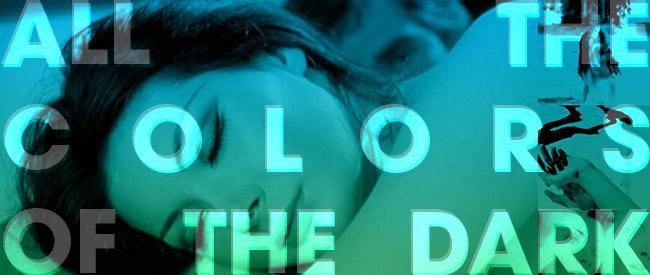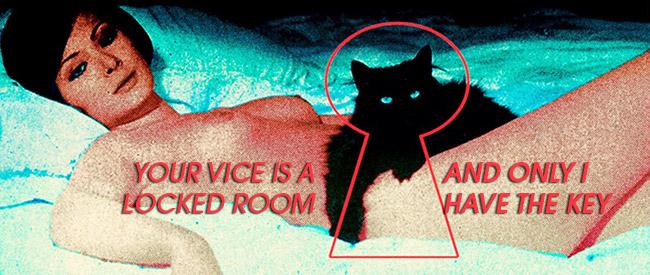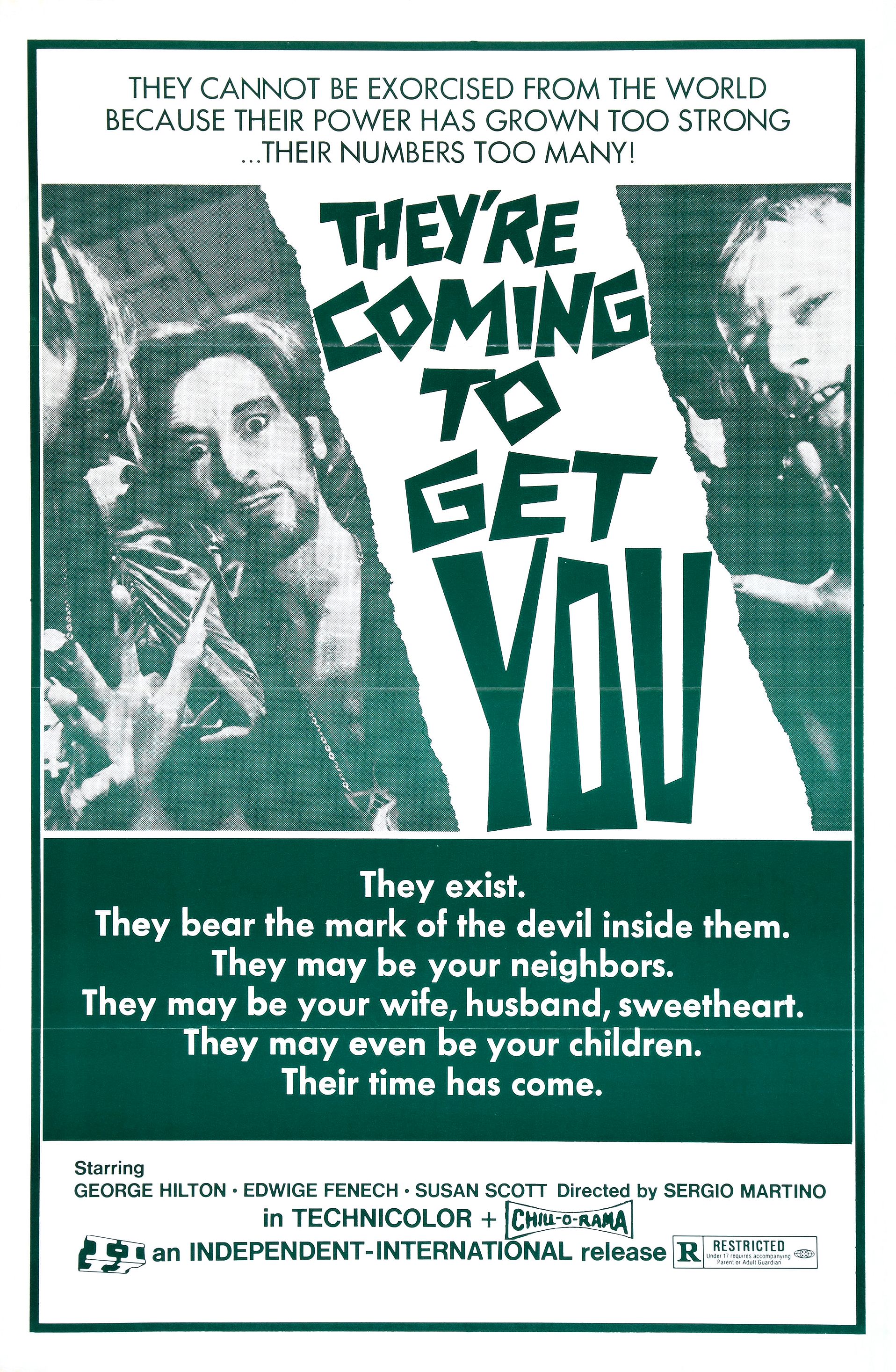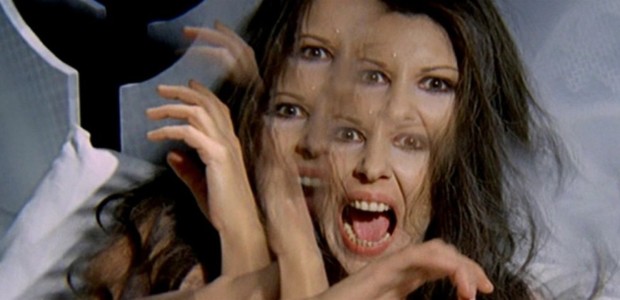
Kat Ellinger is a titanically talented, inventively insightful, and hyper-passionately prolific multimedia authority, philosopher, and educator in the realm of cinema. She also largely focuses on the films, genres, and figures who made them that matter most to Daily Grindhouse devotees.
To attempt to encapsulate Kat’s credits in an intro is a fool’s errand, but here are just a few of her most recent contributions to the cause: she publishes DIABOLIQUE magazine; recently authored ALL THE COLOURS OF SERGIO MARTINO; hosts multiple podcasts; and contributes commentaries and essays to more special edition Blu-rays than seems possible.
On a personal note, Kat is also presently penning the introduction for LAST AMERICAN VIRGINS, my upcoming compendium on teen sex comedies of the 1970s and ’80s, slated to be published by Bazillion Points, in time for Christmas 2018. I am k(at)evelling(er) over it!
The following interview is, in the greatest sense, monstrous and utterly mind-roasting. As is the case with all of Kat’s endeavors, prepare to dive deep and come back up enlightened, elevated, and positively Ellingerized!
Daily Grindhouse: Kat, you are a hero to all of us who share your obsession with films and film culture, and an ongoing inspiration for those of us who attempt to write about it. You constantly produce so much work of extraordinary quality, it’s hard to keep up with it. Please — right here and now — list all the stuff you did in 2017 and what you’re working on in 2018.
Kat Ellinger: Oh wow! Thank you so much. I don’t see myself as a hero to anyone, just an incredibly crazy person who can’t stop working! I hate taking days off. I just get bored. So I have to keep going. I am also British and very bad at taking compliments ha. (But seriously, thank you!)
2017 was a crazy year. It started off with doing my first home video commentary on Borowczyk’s STORY OF SIN (with my DAUGHTERS OF DARKNESS podcast co-host Samm Deighan) for Arrow, and then just spiralled into insanity from there. Samm and I did further commentaries on Mondo Macabro’s BLOOD SPATTERED BRIDE and WHO CAN KILL A CHILD? We did IMAGES for Arrow, THE GORGON for Indicator’s first Hammer Horror set, ALL THE COLOURS OF THE DARK, for Shameless.
And then on top of that we sort of broke out of the horror/exploitation camp to do some really interesting stuff for Kino Lorber — LOVE WITH A PROPER STRANGER, I’LL BE SEEING YOU.
I did my first solo commentaries: THE CREMATOR (one of my favourite Czech films), which Second Run put out on a beautiful Blu-ray upgrade.
Arrow thought it would be a good idea to have me talk about FLOWERS IN THE ATTIC for their release of that, which turned into a bit of a fanfest. I also did some more very interesting things for Kino, like pre-code film TOPAZE, and Ingrid Bergman’s first American film, INTERMEZZO.
On top of that I did video essays or booklets and on camera stuff for a bunch of other home video titles: KILL BABY, KILL; ERIK THE CONQUEROR; DON’T TORTURE A DUCKLING; THE BIRD WITH THE CRYSTAL PLUMAGE; EL CAMINANTE; RAWHEAD REX; THE WITCHES; DER TODESKING; and THE APARTMENT.
I also edited two editions of the DIABOLIQUE print edition (one dedicated to Asian cinema; the other to folk horror, witchcraft and fairy tales), contributed a lengthy chapter to the LOST GIRLS: THE PHANTAMSAGORICAL CINEMA OF JEAN ROLLIN (which was edited by my partner Samm, and published by Kier-La Janisse at Spectacular Optical), and wrote my own book on the films of Sergio Martino, as well as most of my upcoming book on 1971’s DAUGHTERS OF DARKNESS (Devil’s Advocates).
Oh yeah, and podcasts, there was a bunch of them (DAUGHTERS OF DARKNESS, HELL’S BELLES, and guesting with the lovely Mike White over at the Projection Booth). I am getting tired even thinking about this stuff and I am sure there’s something I missed off. I am actually crazy, yes.
This year there’s more of the same. I am finishing up my DAUGHTERS OF DARKNESS book, as well as putting together an collection of essays for a book on the Gothic horror of Hammer Films, written entirely by female historians, which should be due later this year.
More commentaries, it’s hard to keep up with what’s been announced already, but I think I am safe to say SMASHING TIME, UNDER CAPRICORN, TRAPEZE, and IRMA LA DOUCE for Kino. I have a video essay on Arrow’s upcoming US release of WHAT HAVE THEY DONE TO OUR DAUGHTERS? And I just did one for DEATH SMILES ON A MURDERER for them.
I have been doing more Hammer things for Indicator. Their next set of films is due very soon (the third). I was also really honoured to appear on camera for Cult Films for their special edition for SUSPIRIA and give a (long overdue) female perspective for that film.
Daily Grindhouse: Let’s talk specifically, now, about ALL THE COLOURS OF SERGIO MARTINO. Why this filmmaker? Why this book? Why now?
Kat Ellinger: I think Sergio Martino has been grossly overlooked in general film criticism, unjustly so. For example, his contribution to the giallo often gets overshadowed by talk about Dario Argento. Martino wasn’t an imitator though. He created the archetype of “the final girl” in TORSO, which came out a year before BLACK CHRISTMAS and THE TEXAS CHAIN SAW MASSACRE (the two most cited examples of the first final girls).
Apart from Mikel Koven, in his book on giallo films, literally nobody outside of fan circles acknowledges that. Martino had his own style and mode of working, which rarely gets talked about in any depth. He was prolific in Italian low budget film: action, sex comedies, horror, exploitation. We need to be talking about these films, because they are all so bloody entertaining.
Writing the book also gave me the opportunity to really look into his work, including the films he made that have had no international attention. He’s known mainly for his giallo films, yet a third of the films he made were sex comedies. They are all wonderful. You could say the book was a bit of a soapbox for me. I wanted to celebrate Martino for all his colours, and say to people, look he didn’t just make five giallo films (as great as they are), look at all this other stuff! It was a ball to research as well. I was really sad when it was over.

Daily Grindhouse: Why do you think, relatively speaking, Sergio Martino has “flown under the radar” when compared to other Italian filmmakers of his era?
Kat Ellinger: If I am completely honest, I think there tends to be a bit of snobbery involved. Martino is like an Italian Roger Corman. He has never made any illusion to the fact he is doing anything else other than making entertaining, internationally exportable, trashy exploitation films, for the most part.
Because of this, a lot of critical attention tends to go more in favour of say Argento, who can be analysed in terms of being something of an auteur, or his “Freudian” themes etc etc. That isn’t to say there isn’t art involved in the films of Martino. He knows what he is doing, and is a master at turning out films that constantly entertain — even his later work, like the late ‘nineties giallo MOZART IS A MURDERER, has a lot of value in terms of pure entertainment — that also exhibit a lot of craft and ingenuity, despite the lack of budget involved in some cases.
What I have discovered since I wrote the book is, there are so many fans of Martino out there. I think that’s been the best part of project, connecting with them, and discussing the director’s films, sharing the love.

Daily Grindhouse: What are your three favorite Sergio Martino films?
Kat Ellinger: Ugh, I hate naming favourites! Everything is my favourite. But, if I really have to answer this then I am going to have to be slightly controversial.
ALL THE COLOURS OF THE DARK, obviously, because it has all of my favourite things: occult themes, Gothic melodrama, trippy psychedelic aspects, sadism, orgies, Edwige Fenech. Plus, Bruno Nicolai’s score is hands down one of the best soundtracks recorded for a giallo, ever. I just love the fact that Martino really goes out there, channeling the spirit of ROSEMARY’S BABY (another of my favourite films), but then makes it into a free loving sex festival with loads of black magic. It also has all those gorgeous, moody British locations as well; the park where they filmed THE OMEN, and the wonderful mansion, Wykehurst Park, the location for THE LEGEND OF HELL HOUSE (amongst other things). What more can you ask for?
For the other two choices I am going to have to go with comedies. I love sex comedies, especially of the Italian and Spanish variety. There’s something especially entertaining, and not to mention profane, about that combination of Catholic guilt and sex. These were culturally important films, if you consider Italy (and Spain) had a history of fascist oppression, where sexuality was repressed under the name of religion. So, when those barriers got lifted, filmmakers were free to go crazy. In some of the films from that era you can really feel that sense of liberation and excitement, which is a marvellous thing.
I love all Martino’s sex comedies, but if I have to pick just two, then GIOVNONNA LONG-THIGH (1973) is a blast. It stars Edwige Fenech as a potty -mouthed sex worker, who is hired to pose as an industrialist’s wife in order to pull off a blackmail scam so he can get his cheese factory back in action (after the health inspector closes it down). This woman is incredibly beautiful, so the idea is she will be the honey trap, but every time she opens her mouth, a tirade of foul language comes out. Of course, then everyone gets on a train, and it’s going into the wrong carriages, slapstick, swearing, clothes being ripped off, whilst trying to stop this woman from speaking.
People always associate Edwige with the giallo, but like Martino said — who she did a fair bulk of her seventies work with, and she was in a ten year relationship with his brother Luciano, who produced most of the films — her “sunny disposition was more suited to comedy. I have to agree with Sergio. Her sense of timing was just brilliant. She was so adept at physical comedy, with or without sexual aspects. She was far more prolific in this genre too, it’s just hardly anyone talks about it, which I think it quite tragic.
On that note my second comedy choice, and third overall, has to be CREAM HORN (1981). This stars Edwige, again, as an opera singer who wants to get away from her abusive boyfriend. She accidently falls for a married man (played by Lino Banfi) who he passes himself off as his promiscuous neighbour, smuggles her into the apartment above his wife and family, and well, you can imagine the rest. Lino Banfi is just amazing. He looks like an Italian Danny Devito, and his role in most of these films was to play this kind of balding, sexually inept character, who ends up getting into trouble with beautiful women. It’s as absurd as it sounds, and that’s one of the reasons I love these films so much.
Daily Grindhouse: What is your LEAST favorite Sergio Martino film, and why?
Kat Ellinger: Mean! Okay, CASABLANCA EXPRESS (1989), because I don’t know whose idea is was to get Jason Connery out to Morocco for some weird WWII spy thing, which involves a kidnap attempt on the worst Winston Churchill lookalike ever committed to celluloid (the likeness is so awful they keep him unfocused when in shot), but it wasn’t a very good one. This said, the film does have Donald Pleasence in it, and it also has Jean Sorel. And it is amazingly entertaining. This is about as close as I can get to not liking a Martino film, I am afraid. Sorry.
Daily Grindhouse: Let’s switch to DIABOLIQUE. You are the editor-in-chief of a print and digital magazine that thrives in a time when it seems like no other publications can. That DIABOLIQUE is brilliant is obvious to anyone who reads it — but often, as so many of us known, brilliance is not enough to keep a project afloat. What is it, then, that keeps DIABOLIQUE so vital and vibrant and, frankly, alive and screaming in the present media landscape?
Kat Ellinger: DIABOLIQUE is a pure passion project. I think that’s what shines through. I wanted to make it into a platform where writers could really share what they love, as well as giving them the opportunity to write deep, longform essays, when they feel like it, instead of just clippy film reviews like a lot of other places dictate. Just offering that freedom and space.
You are right, it is hard to survive in print now. We’ve had to scale back our operation bigtime, because we just cannot sustain the costs of print. We used to sell in Barnes and Noble, but with the overheads, and the fact that you can only get into big stores with a distro, who take a massive cut of any profit, it was pull back, or die. So we remodelled everything and went back to grass roots. We sell exclusively through our website now, which basically just covers our overheads. Sadly, we don’t publish as much in print either, only two issues last year, but we do try and keep the website loaded with quality content, which is free for everyone to read.
I don’t think the magazine would survive if it wasn’t about passion. We have refused to sell out and pay lip service to PR, in order to remain indepedendent. Of course, that doesn’t pay the bills, but it means we can keep our integrity. And so, we have created a little family, all kind of working for the same cause. I love that about the magazine. It’s a sense of community and sharing of ideas. I don’t think that would work if we were more commercially focused. Instead, we are free to say what we want, and that can be an incredibly inspiring thing. I love the writers, and editors, they all bring something unique to the table. I can’t see us changing it now. It wouldn’t be the same.
Daily Grindhouse: Talk to us a bit about how DIABOLIQUE came to be and what goes into creating each issue.
Kat Ellinger: I am one of a long line of editors. Everyone has had their own vision for the magazine, so it’s had a few different identities over the years. It started off devoted to Gothic horror (I think we are in our 8th year now). We still have that focus in a lot of ways, but when I took it on I wanted to diversify into all areas of cult film, art, culture, literature, music. Anything that’s worth talking about and celebrating really.
We usually work on themes for the issues, although I don’t know if that will continue. I usually come up with the central idea, after discussing it with my core editorial team (I currently have seven wonderful editors who all work on their own areas of interest), then I throw it out to the writers and see who wants to pitch.
It really is a community venture and I couldn’t do it without all the help from everyone. We all pitch in together, proofing, editing. Dima, our publisher, works for weeks putting all the brilliant layouts together (and sorry, other magazines, no disrespect, but ours are phenomenal).
The energy and creativity involved is amazing. It’s also challenging though, because it’s a lot of hours, and we aren’t making any money from it. Again, this is where the passion comes in. It’s basically like some insane ROCKY training montage for a couple of months where we are running around like headless chickens. Then the issue comes out. We have a couple of weeks to rest, then I go and say, guys, how about?
I also wanted to mention that when I came onboard we had very few female writers. Now we are about 50/50 male to female ratio. I have been writing for DIABOLIQUE since 2013, as has Samm Deighan (my associate editor), but we were outnumbered by men.
So, another core point in my mission statement was to encourage more female writers to come to us, in order to support and nurture them. It’s hard being a woman in a very male dominated industry. That fact is thankfully, albeit slowly, starting to change. But you do face a lot of obstacles, just from the casual and institutionalised sexism, in the industry, along the way.
As a result I have found more women tend to lack confidence when it comes to pitching ideas, or coming forward and promoting themselves. I wanted to do my bit to change that. It’s a very important part of DIABOLIQUE and what we do.
Daily Grindhouse: Now let’s switch, again, to podcasting. Talk to us about DAUGHTERS OF DARKNESS and HELL’S BELLES — what each show is, who your co-hosts are, and what it’s like undertaking them.
Kat Ellinger: I love podcasting so much. Like writing for DIABOLIQUE I see it as a free space to say what I want, when I want. They really are liberating in that respect. DAUGHTERS I do with Samm, and we have been running for two and a half years now. HELL’S BELLS is with the wonderful Heather Drain, who is a well established writer who focuses on fringe cinema and music.
With DAUGHTERS OF DARKNESS, we focus on weird cult film and arthouse cinema. We’ve done episodes on giallo, Zulawski, lesbian vampires, Elio Petri, Larraz, Rollin, and even Almodovar, amongst others. It’s very research intensive, as anyone who has listened will be able to tell, although we did do one unprepared episode about “our favourite things”, which showed I shouldn’t be let free without guidance because I was there telling really inappropriate stories about the first time I saw THE IDIOTS, as well as crediting Steve Austin of THE SIX MILLION DOLLAR MAN with directing VIRGIN WITCH.
HELL’S BELLES is slightly more esoteric, in line with the amazing Heather, who is literally a font of obscure knowledge. She constantly amazes me so much. On our Radley Metzger episodes, I was just there mouth agog at the things she was coming out with. Incredible lady. We did record some Kenneth Anger episodes around Christmas and they are still stuck in editing! Which is frustrating. But there aren’t enough hours in the day. For the same reason, DAUGHTERS has also stalled, although we did set up a Patreon recently with the hope it would help us record more.
So much work goes on behind the scenes. When we first started I thought you just speak and that’s it. Wrong, ha. There’s so much editing and adding music and clips that these episodes take on a life of their own. It’s all worth it though. Hopefully, this year I can commit more time to both podcasts because when I’m not recording I get really sad about it.
Daily Grindhouse: Officially now, I — Mike “McBeardo” McPadden —would like to annouce that I am honored and humbled to have you writing the intro for my upcoming book LAST AMERICAN VIRGINS. Can you talk to us a bit about that project, that genre, and what your take on it might be?
Kat Ellinger: I can’t begin to tell you how excited I am to be involved! I am quite vocal about how I see things going culturally at the moment, and I don’t like it. This re-writing, or washing out historical art, cinema, literature, just because it seems offensive to today’s sensibilities, seems to me like an extreme form of oppression.
As a rebel, and a punk rocker (always), I won’t stand for it. We can accept that things from the past are “problematic” (I hate that word) without denying them space. Context is everything; nuance is everything. And I feel we have lost the ability to keep that perspective. Not everything is black and white. We can look at art in different ways. But only if we refuse to give in to this pressure that says we must avoid everything that hurts our feelings, or makes us uncomfortable. In fact, if you ask me, that’s exactly what we need to be looking at, gaining insight into.
I am a sociologist at heart. My degree was in social sciences with an emphasis on sociology, social construction theory, the evolution of social policy, the sociology of deviance. When I write about film, and it’s rare I will ever write about contemporary film, it’s always classic, vintage stuff, I love picking apart the cultural subtext, because I think not only does that give us an insight into what these films were saying, it tells us a lot about society too.
Take a filmmaker like Jess Franco for example. On the surface he is condemned as being sexist, obsessed with objectifying women in his films. Scratch into the cultural context and you will see that Franco came from a very oppressed culture, Francoist Spain, and therefore his films become a powerful statement against that.
The two genres in film that tell us most about society — our hopes, dreams, fears, anxieties — are horror and comedy. In a way they become cultural artifacts for a time and place, and they should always be valued for that very reason. Which is why I naturally tend to gravitate toward them. There is so much to unpack — in comedy even more so. It makes writing about these films a wet dream for someone with my strange fixation on culture, and social roles.
’80s comedies have become an easy target lately for this whitewashing, given a lot of them focus on young men trying to get laid (but then, isn’t that what most comedy is about? Look at the Pre-code era for example!) and I have seen, much to my annoyance, this attitude to kickback and accuse them of being outright misogynistic.
We often see words like “creepy” “rapey” etc etc being bandied around to describe some of the typical protagonists, without one single thought given to context. But then, if you take a moment and you start unwrapping these films, they tell us a lot about what was going on at the time, in terms of anxiety for young people, especially men, as well as the wider cultural context. Sex comedies are far more sophisticated than they are often given credit for. So I am really looking forward to getting stuck into unpacking some of that social context, and examining it in its rightful time and place, not by our standards today. Oh yes, and I love writing about sex, and come on, these films are a hell of a lot of fun!
Daily Grindhouse: What’s next for you?
Kat Ellinger: Well, at the moment I am knee deep in editing the Hammer project. I am also slowly, very slowly, working on a project about Italian comedy. This one is going to be a slow burner just in terms of getting my hands on material. I am even taking Italian lessons as well, because a lot of it is unsubbed where it can be found. But, my next immediate project is going to be a book on Hollywood Gothic Melodrama and Noir, called ARSENIC AND OLD LACE, which I am really looking forward to starting. So much social context, so much deviance, so much damned Gothic. I can’t wait!
Tags: Interviews, Kat Ellinger


No Comments